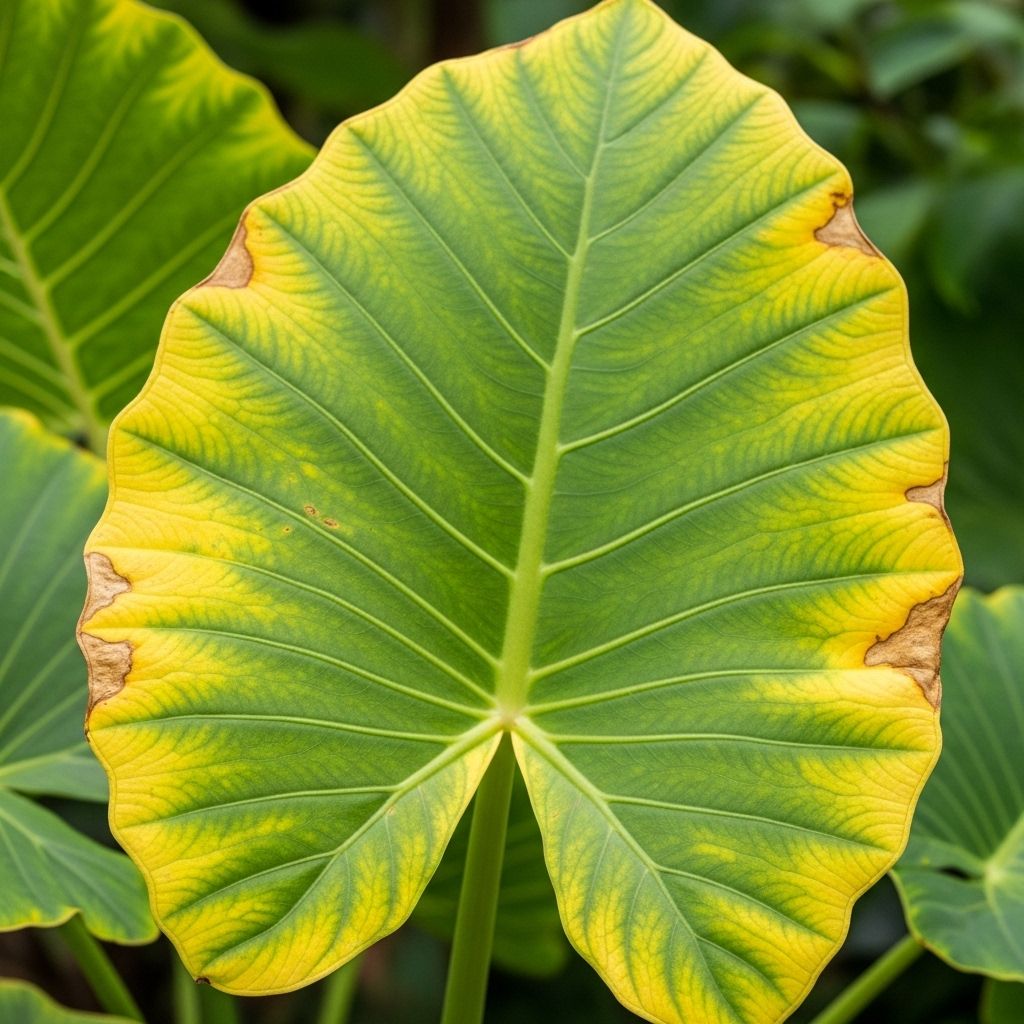Elephant Ear Plant Leaves Turning Yellow: 8 Causes And Fixes
Experiencing yellow or brown leaves on your elephant ear plant? Uncover eight common causes, expert solutions, and essential care tips.

Image: HearthJunction Design Team
8 Reasons Your Elephant Ear Plant Leaves Are Turning Yellow or Brown
Large, dramatic, heart-shaped leaves make elephant ear plants a favorite among gardeners and houseplant enthusiasts. Yet, these lush tropical wonders sometimes develop yellow or brown leaves—and while a little color change is natural, frequent leaf discoloration can signal deeper problems. In this comprehensive guide, we’ll cover the eight most common causes of yellowing or browning leaves in elephant ear plants, alongside effective remedies and expert care tips to maintain vibrant foliage year-round.
Contents
- Improper Watering
- Nutrient Deficiency
- Insufficient or Excess Light
- Pest Infestation
- Disease and Fungal Infection
- Natural Aging
- Environmental Stress
- Improper Fertilizing
- Prevention and Maintenance Tips
- Frequently Asked Questions (FAQs)
Improper Watering: Overwatering & Underwatering
Watering issues are the most common reason for elephant ear plants developing yellow or brown leaves. Both over-watering and under-watering can create similar symptoms, such as yellow spotting that spreads to the whole leaf.
- Overwatering causes roots to suffocate, making them unable to absorb nutrients. Saturated soil encourages root rot and fungal issues, both of which result in yellow or brown leaf tissue.
- Underwatering limits the plant’s access to water, which is needed to transport nutrients throughout the plant. As a result, leaves typically turn yellow, wilt, and may develop brown edges or tips.
How to Fix:
- Check your plant’s soil before watering. Stick a finger or moisture meter into the soil up to two inches deep—only water if it feels dry at that level.
- Ensure your pot or garden bed offers excellent drainage to avoid soggy roots.
- Establish a consistent watering schedule—generally once a week for indoor elephant ears, or more frequently during hot weather for outdoor specimens.
Nutrient Deficiency
Elephant ear plants are heavy feeders and require a balanced supply of nutrients for healthy, green foliage.
- Nitrogen Deficiency typically results in older leaves turning yellow first, as the plant moves nutrients to new growth.
- Poor soil quality, depleted potting mix, or lack of fertilization can cause nutrient shortages leading to pale, yellow, or brown leaves.
How to Fix:
- Fertilize regularly during the active growing season (spring and summer). Use a balanced, water-soluble fertilizer or slow-release formula. Indoor plants benefit from feeding every 2–4 weeks, while outdoor plants can be fertilized 1–2 times per month.
- Consider supplementing with micronutrients (magnesium, iron) if yellowing persists.
Insufficient or Excess Light
Elephant ear plants flourish in bright, indirect sunlight. Inadequate or excessive light can cause stress, resulting in yellowed or scorched leaves.
- Too Little Light: Leaves turn yellow and growth becomes leggy or stunted.
- Too Much Direct Sunlight: Causes brown, crispy edges and sunburn spots on leaves.
How to Fix:
- Place your plant in a location with filtered sunlight. Outdoors: dappled shade or partial sun. Indoors: near a bright window with sheer curtains.
- Avoid prolonged direct midday sun, especially for indoor plants. Rotate your pot monthly for balanced growth.
Pest Infestation
Common pests such as spider mites, aphids, and mealybugs may attack elephant ear plants, which weakens the leaves and often causes yellowing, spotting, or browning.
- Pests suck sap from the leaves, reducing their ability to photosynthesize and transport nutrients.
- Heavy infestations may cause leaves to yellow and drop prematurely.
How to Fix:
- Inspect both sides of the leaves and stems for visible pests or webbing.
- Treat minor infestations by rinsing the plant with water or wiping leaves thoroughly with a damp cloth.
- More persistent pests can be controlled with insecticidal soap, neem oil, or horticultural oils. Always follow label instructions.
Disease and Fungal Infection
Yellow to brown leaf spots can be an early warning sign of plant disease, particularly root rot and fungal infections, often caused by consistently wet soil.
- Root Rot: Results from waterlogged soil, leading to mushy roots, yellow leaves, stunted growth, and eventual collapse.
- Leaf Spot Diseases: Appear as small yellow, brown, or black blotches, often with a yellow halo.
How to Fix:
- Remove affected leaves immediately to prevent the spread of disease.
- Improve air circulation around your plant by spacing plants appropriately and pruning overcrowded foliage.
- Allow the soil surface to dry between waterings, and never let the pot sit in excess water.
- If root rot is present, remove the plant from its pot and trim away all rotted roots. Repot in fresh, well-draining soil.
Natural Aging
It’s perfectly normal for older elephant ear leaves to yellow and die as they age. Typically, this happens to the outermost leaves while the plant continues to produce new growth from the center.
- One or two yellowing leaves at the base, with the rest of the plant looking healthy, is generally not a concern.
- If new and old leaves are yellowing en masse, investigate for other issues like disease, pests, or care problems.
How to Fix:
- Gently prune or trim away aged, yellowing leaves to encourage the plant to focus energy on new growth.
Environmental Stress: Temperature & Humidity
Elephant ears are sensitive to environmental changes. Extreme temperatures, drafts, or low humidity can shock the plant, resulting in yellow or brown leaves.
- Cold Damage: Leaves droop, turn yellow, or develop brown blotches in response to unexpected cold (below 50°F/10°C).
- Low Humidity: Causes leaf edges and tips to brown and curl, particularly indoors during winter or in dry climates.
How to Fix:
- Maintain indoor temperatures between 65–85°F (18–29°C).
- Raise humidity by grouping plants, misting leaves, or using a room humidifier.
- Avoid exposing plants to drafts or sudden temperature swings.
Improper Fertilizing
Both too much and too little fertilizer can stress elephant ear plants:
- Excess fertilizer: Can cause salt buildup in the soil, burning roots and browning leaf tips.
- Insufficient feeding: Starves the plant of essential nutrients, leading to pale yellow leaves and poor growth.
How to Fix:
- Fertilize regularly during the growing season, but reduce or stop feeding in autumn and winter when the plant is dormant.
- If you suspect fertilizer buildup, flush the soil with plenty of water to wash away excess salts.
Prevention and Maintenance Tips for Vibrant Elephant Ear Foliage
- Proper Watering: Check soil moisture regularly and adjust your watering schedule for season and plant location.
- Lighting: Provide bright but indirect sunlight, rotating plants monthly for even growth.
- Humidity: Keep humidity high for indoor plants, especially during dry seasons.
- Pruning: Remove aging or damaged leaves to encourage vigorous new growth.
- Cleaning: Wipe down leaves regularly with a soft, damp cloth to maximize light absorption and reduce dust and pests.
- Fertilization: Use a balanced fertilizer during the growing months, mindful not to over-fertilize.
- Monitor Pests: Regular inspection helps catch minor pest problems before they become severe.
Common Causes Comparison Table
| Cause | Symptoms | Solutions |
|---|---|---|
| Overwatering | Yellow, wilted leaves, soggy soil | Reduce watering, increase drainage |
| Underwatering | Dry, crisp yellow leaves | Increase watering, maintain soil moisture |
| Nutrient Deficiency | Pale/yellow older leaves, stunted growth | Fertilize with balanced nutrients |
| Insufficient Light | Yellowing, leggy stems | Move to brighter location |
| Pests | Yellow spots, leaf drop, visible insects | Inspect and treat with insecticidal soap |
| Disease/Root Rot | Yellow leaves, mushy roots, brown spots | Remove affected tissue, repot if needed |
| Natural Aging | Older outer leaves yellow, new growth healthy | Prune old leaves, no action needed |
| Environmental Stress | Yellow or brown edges, leaf curling | Increase humidity, avoid drafts/cold |
Frequently Asked Questions (FAQs)
Q: Is it normal for elephant ear leaves to turn yellow?
Yes, it’s normal for a few older leaves to yellow and drop as they age. However, extensive yellowing usually points to problems such as improper watering, poor nutrition, or pests.
Q: How often should I water my elephant ear plant?
Water once the top 1–2 inches of soil feel dry. On average, this is once per week for indoor plants, but more frequent for outdoor plants in warm climates. Always check moisture levels before watering.
Q: Can too much fertilizer cause yellow leaves?
Yes. Excess fertilizer can burn roots and create nutrient imbalances, leading to yellow or brown leaf tips. Flush the soil with water if you suspect salt buildup.
Q: What kind of light do elephant ear plants prefer?
Bright, indirect sunlight is ideal. Outdoors, plant in partial shade. Indoors, place near a bright window but protect from harsh midday rays.
Q: How do I revive a droopy, yellowing elephant ear?
First, check for root rot or waterlogged soil. Adjust watering habits, prune dead or damaged leaves, and move the plant to an area with optimal light and humidity. Repot if roots are decaying.
Conclusion
Yellow or brown leaves on elephant ear plants are a common sight and often fixable with slight adjustments to care routines. Most issues originate from watering mistakes, poor nutrition, unsuitable lighting, pests, or environmental changes. By understanding these causes and following the preventive steps outlined above, your elephant ear can stay lush, healthy, and vibrant for years to come.
References
- https://www.epicgardening.com/elephant-ear-plants-turning-yellow/
- https://www.gardenninja.co.uk/forum/topic/elephant-ear-turning-yellow-and-drooping/
- https://www.housedigest.com/1375465/fix-elephant-ear-plant-leaves-turning-yellow/
- https://www.homesandgardens.com/gardens/why-is-my-elephant-ear-plant-turning-yellow
- https://nurserynearme.com.au/blogs/blog/elephant-ear-plant-care
Read full bio of Srija Burman












